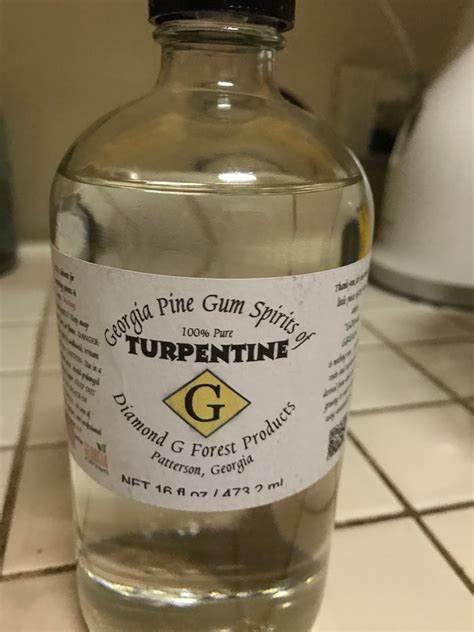Turpentine, a volatile and flammable liquid distilled from the resin of coniferous trees, has a rich history intertwined with human civilization. From ancient times to the modern era, this unique substance has found applications in various fields, ranging from art and medicine to industry and even warfare. This article delves into the fascinating world of turpentine, exploring its origins, properties, uses, and safety considerations.
Historical Roots
Evidence suggests that Egyptians, Greeks, and Romans utilized it for various purposes, including embalming, medicinal treatments, and the production of paints and varnishes. The word “turpentine” itself is believed to have originated from the Greek word “terebinthus,” referring to the terebinth tree, a source of resin used to produce the substance.
Production and Properties
Turpentine is primarily obtained from the resin of pine trees, particularly species like the longleaf pine and slash pine. The resin, a sticky substance that oozes from the tree’s bark, is collected through various methods, including tapping and chipping. The collected resin is then distilled to separate turpentine from other components like rosin.
Turpentine is a complex mixture of hydrocarbons, primarily consisting of terpenes, a class of organic compounds. These terpenes give turpentine its characteristic pungent odor and volatile nature. It is a colorless to pale yellow liquid with a low boiling point, making it easily evaporable.
Types of Turpentine
Gum Turpentine: Obtained from the resin of living trees, gum turpentine is considered the purest form.
Wood Turpentine: Extracted from pine stumps and waste wood during paper production, wood turpentine is a less expensive and more readily available option.
Sulfate Turpentine: A byproduct of the sulfate process in paper manufacturing, sulfate turpentine has a distinct odor and composition compared to other types.
Diverse Applications
Turpentine’s versatility has led to its widespread use across various industries:
Art and Painting: Historically, turpentine has been a crucial component in oil painting. It acts as a solvent and thinner for oil paints, allowing artists to adjust the viscosity and achieve desired effects. It also helps to clean brushes and remove excess paint.
Industrial Uses
Paint Thinners and Solvents: Turpentine remains a common solvent in paint thinners and removers, effectively dissolving oil-based paints, varnishes, and resins.
Chemical Intermediate: It serves as a starting material for the production of various chemicals, including camphor, terpineol, and other terpene-derived compounds.
Cleaning Agent: Turpentine’s solvent properties make it effective for cleaning greasy surfaces, removing tar, and degreasing metals.
Insect Repellent: Due to its pungent odor, turpentine has been used as a natural insect repellent.

Traditional Medicine
Antiseptic and Anti-inflammatory: In traditional medicine, turpentine has been used topically to treat minor skin infections, bruises, and muscle aches.
Respiratory Issues: Inhaled vapors of turpentine (under strict medical supervision) have been used to treat certain respiratory conditions, although this practice is not widely recommended due to its potential risks.
Other Uses
Perfumery: Turpentine is used in the production of some perfumes and fragrances.
Wood Preservation: It has been used to treat wood to protect it from decay and insect infestation.
Safety Considerations
While turpentine offers numerous benefits, it is crucial to handle it with care due to its flammability and toxicity.
Flammability: Turpentine is highly flammable and should be kept away from heat, sparks, and open flames.
Toxicity
Inhalation: Inhaling turpentine vapors can cause irritation to the respiratory tract, leading to coughing, dizziness, and headaches. In severe cases, it can cause more serious health issues.
Skin Contact: Prolonged or repeated skin contact can cause skin irritation, dryness, and dermatitis.
Ingestion: Ingesting turpentine can be extremely harmful, causing severe gastrointestinal upset, liver damage, and even death.
Proper Handling and Storage
Always use turpentine in well-ventilated areas.
Wear appropriate protective gear, such as gloves, eye protection, and respiratory protection.
Store turpentine in tightly sealed containers away from heat sources and incompatible materials.
Keep turpentine out of reach of children and pets.
Modern Alternatives and Sustainability
Due to its potential health and environmental concerns, there is a growing interest in finding safer and more sustainable alternatives to turpentine.
Synthetic Solvents: Many synthetic solvents, such as mineral spirits and citrus-based solvents, have been developed as alternatives to turpentine in various applications.
Water-Based Products: Water-based paints and coatings are becoming increasingly popular, reducing the need for solvent-based products like turpentine.
Sustainable Harvesting Practices: Efforts are being made to promote sustainable harvesting practices for turpentine, minimizing environmental impact and ensuring the long-term viability of pine forests.
Final Thoughts
Turpentine, a volatile with its rich history and diverse applications, remains a fascinating substance. While its traditional uses continue to evolve, it is crucial to prioritize safety and explore more sustainable alternatives to minimize potential risks. By understanding the properties, uses, and safety considerations associated with turpentine, we can harness its benefits while minimizing its potential drawbacks.
FAQs
What is turpentine and how is it obtained?
Turpentine is a volatile and flammable liquid distilled from the resin of coniferous trees, primarily pine trees. It’s a complex mixture of hydrocarbons, primarily consisting of terpenes, which give it its distinctive odor. The resin is collected from the trees through methods like tapping or chipping, and then distilled to separate turpentine from other components.
What are the main uses of turpentine?
Turpentine has a diverse range of applications. Historically, it played a crucial role in shipbuilding, being used to seal seams and coat hulls. In art, it’s widely used as a solvent and thinner for oil paints, allowing artists to adjust the viscosity and achieve desired effects. Industrially, it serves as a solvent in paint thinners and removers, a starting material for the production of various chemicals, and a cleaning agent.
Is turpentine safe to use?
No, turpentine is not entirely safe. It is highly flammable and can pose significant health risks. Inhaling its vapors can irritate the respiratory tract, causing coughing, dizziness, and headaches. Skin contact can lead to irritation, dryness, and dermatitis. Ingesting turpentine can have severe consequences, including gastrointestinal upset, liver damage, and even death.
To read more, Click Here












Leave a Reply